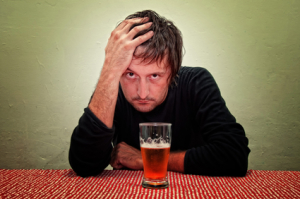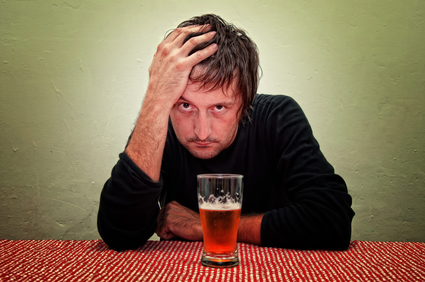
There is an alleged “cure” for alcoholism. Yes, “cure.” It’s called “The Sinclair Method.” It actually encourages individuals to drink, but only after taking naltrexone or nalmefene before they start drinking. Naltrexone and nalmefene are opiate agonists (drugs that blocks opioid receptors in the brain). The theory is their use before drinking will reduce the neurological “reward” after drinking. The “cure” claim is that this reduction eventually leads to the extinction of the person’s desire to drink because they no longer catch the same buzz when they drink.
This is not a joke. The Sinclair Method has its own facebook page; it is promoted in a new documentary, “One Little Pill,” which also has its own facebook page. The original research was done by David Sinclair, and published in the journal, Alcohol & Alcoholism in 2001. You can see the original article here or here. Sinclair believes that drinking alcohol is a learned behavior. Some individuals (partly for genetic reasons) get so much positive reinforcement from drinking, that the behavior becomes too strong for them to control. “They cannot always control their drinking; they cannot ‘just say “no”.’ And society calls them alcoholics.”
The use of the Sinclair Method is said to remove “the neural changes that have caused alcoholism—the over-strengthened pathways of neurons that have developed in the brain, causing alcohol craving and excessive drinking.” The basic premise of the treatment method is that addiction is a learned behavior that has become so entrenched that the addict can no longer control it. “Alcohol drinking produces reinforcement and is learned through that reinforcement.”
Sinclair’s method is the subject of a book by Roy Eskapa, The Cure for Alcoholism. Eskapa said the book’s title means what it says: “Addiction to alcohol can now be cured—not through abstinence, but by always taking a medication an hour before drinking alcohol.” The reduction in cravings is progressive, with the strongest effects in evidence three to four months after beginning to use the Sinclair Method. “The benefits continue increasing indefinitely so long as you take naltrexone if and when you drink.”
Eskapa claimed that the Sinclair Method does not need to be done in conjunction with “extensive counseling.” He based this on his understanding of a study called Project COMBINE. “As a result of this study, naltrexone is no longer just for large clinics specializing in alcohol problems; now, any licensed doctor can ethically and safely prescribe naltrexone for problem drinking.” Citing clinical trials in Finland and the U.S., he said that naltrexone treatment was only effective when it was taken at the same time that alcohol was being drunk. “Until now, most doctors and addiction experts were unaware that to cure alcoholism, one has to drink alcohol while naltrexone is in the bloodstream.”
What the COMBINE study actually found was that all treatment groups experienced a large increase in the percentage of abstinent days, a factor of three times greater. The treatment groups for naltrexone alone, treatment alone and the combination of treatment and naltrexone had comparable outcomes. It did not conclude that treatment wasn’t needed. What it said was: “Medical management of alcohol dependence with naltrexone appears to be feasible and, if implemented in primary, and other, health care settings, could greatly extend patient access to effective treatment.”
Before you seek out a doctor to prescribe naltrexone (nalmefene is not approved by the FDA for use in the U. S. at this time), let’s look at this alleged “cure.” First, alcoholism is reductionistically conceived as a learned behavior. And the treatment or “cure” is the systematic application of a behavior modification technique known as extinction. Now, the science behind extinction, and the reduction in drinking by using the Sinclair Method is clear. When you positively reinforce a behavioral stimulus, the individual person (or hamster) will do the behavior more. When you stop positively reinforcing the behavior, it will decrease in frequency. This systematic decrease is extinction. Here is a short YouTube primer on the four basic elements of classical conditioning, if you’re interested.
So here’s the kicker. The “cure” is contingent upon continuing the extinction process. In other words, you need to continue taking the medication an hour before you plan to drink . . . forever. But you can resume drinking for the positive reinforcement of the high simply by not taking your pill. So the “cure” is also contingent upon the motivation level of the potential drinker to take the drug before drinking. This is not a “cure” for alcoholism in my way of thinking.
Alcohol in high enough concentrations in the blood stream can cause unconsciousness, stop your breathing leading to cardiac arrest and other physical problems. The physiological effects from alcohol in your blood stream continue to occur even if the neurological reward for drinking is neutralized. The Sinclair Method does not stop these other effects from occurring. It simply neutralizes the reward from drinking and gradually extinguishes the cravings to drink. It does not metabolize the alcohol in your system.
Understanding what is actually treated by the Sinclair Method is slippery. Eskapa’s book title says it’s a “cure” for alcoholism. But he speaks about “alcohol drinking” being positively reinforced to the point that some individuals (excluding those with a genetic predisposition) cannot control their drinking and are called alcoholics. Alcoholism is more than just a learned behavior or an out-of-control behavioral reinforcement strategy. It’s not something that pharmacological extinction can remove or cure. “It’s like a switch, clickin’ off in my head. Turns the hot light off and the cool one on, and all of a sudden there’s peace” (“Brick” from: Cat on a Hot Tin Roof).





